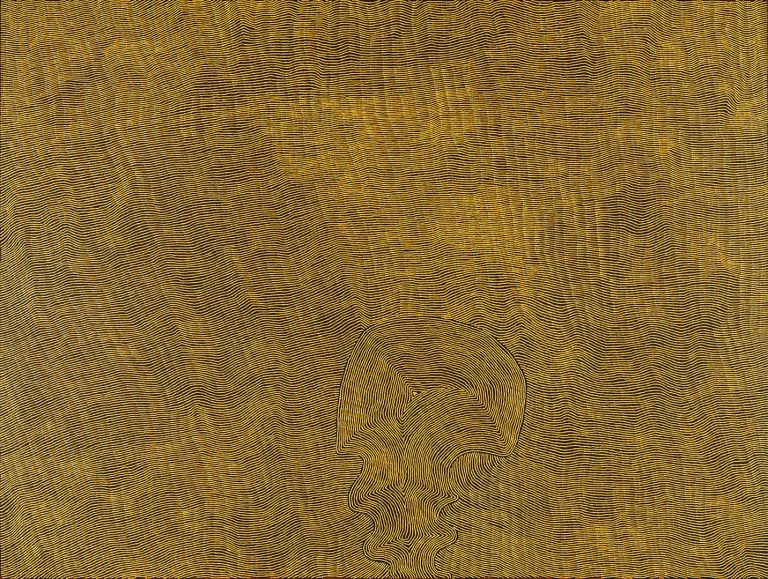We acknowledge the Traditional Owners of the land on which the Queensland Art Gallery | Gallery of Modern Art stands and recognise the creative contribution First Australians make to the art and culture of this country.

Yukultji Napangati / Pintupi people / Australia b.c.1970 / Untitled 2014 / Synthetic polymer paint on Belgian linen / 183 x 242cm / The James C. Sourris AM Collection. Purchased 2015 with funds from James C. Sourris AM through the QAGOMA Foundation / Collection: QAGOMA / © Yukultji Napangati
Yukultjin NapangatiUntitled 2014
On Display: GOMA, Gallery 3.4, Gallery 3.3
Untitled uses Yukultji Napangati’s typically restrained palette of straw yellow to burnt umber in alternating sequences of under a dozen dots. This allows the lines to be read horizontally, while colours are read vertically.
The repetitive undulating nature of the lines adds to its shimmering, rain or wave-like meditative nature. In this painting Napangati interrupts her usual dotted-line composition with a mushroom-shaped intervention. This eruption speaks to the many associations Yunala (Bush Banana Dreaming) has to sites, seasons, landscape and ceremony in the Western Desert.
Yunala is a rockhole and soakage water site among sandhills to the west of the Kiwirrkura community in Western Australia. During ancestral times a group of women camped at this site after travelling from further west. While at Yunala the women camped beside the rockhole, digging for the edible roots of the bush banana (Marsdenia australis) also known as yunala.
The sinuous lines in this work represent the sandhills in the area and the yunala tubers growing beneath the ground, while the interrupting shape may relate simultaneously to flowing water during rainy periods between the great lakes of the Western Desert and the digging of the tubers.
Yukultji Napangati paints in a linear and optical style characteristic of Pintupi artists, creating vibrant, shimmering aerial landscapes that poetically convey lived and learned experience of place. Now based in Kiwirrkura and a member of the Papunya Tula co-operative, she began painting in 1996 following in the footsteps of senior women Pintupi artists such as Makinti Napanangka, Inuywa Nampitjinpa and Walangkura Napanangka. Napangati’s recent paintings refer to seasons, significant sites, landscapes and ceremonies in the Western desert, using sinuous lines to describe sand hills and mushrooming shapes disrupting the dotted line composition to invoke the flowing water of the rain season. Napangati’s story is particularly fascinating. From her birth until 1984 she had no contact with white people, living with eight members of her immediate family (the so-called ‘lost tribe’) in an area of Country to the west of Lake Mackay, on the border between Western Australia and the Northern Territory.